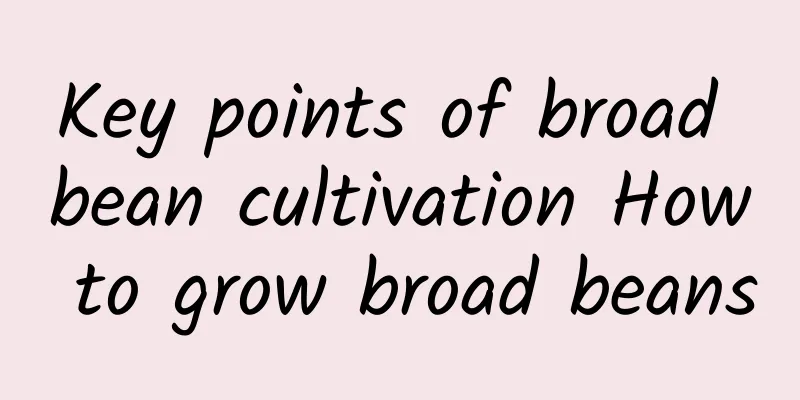Key points of broad bean cultivation How to grow broad beans

|
What issues and matters should we pay attention to when cultivating broad beans? Today we will introduce them to you: (1) Choose the right crop rotation and plot:Broad beans should not be planted continuously. Continuous planting will make the plants sterile. The number of rhizobia is small, the activity is low, the pods are few, and they are prone to disease. When planting broad beans, crop rotation should be implemented for at least 3 years. Broad beans are adapted to slightly heavy and moist soil, but it is better to plant them in deep, fertile clay loam or sandy loam. (2) Sowing at the right time:Broad beans are cold-resistant and can be sown from late February to mid-March. Before sowing, deep plow the soil and apply appropriate basal fertilizer to make a flat bed 1 meter wide. Plant two rows in each bed, dig holes in the bed, the hole depth is 6-9 cm, the hole distance is about 20 cm, sow 2-3 seeds in each hole, and level the bed surface. (3) Top dressing and watering:Adequate water supply should be provided 1-2 days after sowing to promote early germination and early uniform seedlings. When the seedlings grow to 3-4 true leaves, an appropriate amount of nitrogen fertilizer should be applied, and phosphorus and potassium fertilizers should be applied in stages during the growth period. Spraying potassium dihydrogen phosphate or trace elements such as boron, molybdenum, magnesium, and copper during the flowering and pod-setting period can reduce flower and pod drop, promote seed development, and increase yield. In the early stage of broad bean growth, inter-cultivation is the main method to increase soil water retention and permeability. The soil should be kept moist from the beginning of budding and flowering. Lack of water during the flowering and pod-setting period can easily cause flower and pod drop, and the beans will not be full. (4) Cultivation and pruning:After the broad bean seedlings emerge, the seedlings should be checked and the gaps should be filled in time. During the seedling stage, multiple intertillage and weeding should be carried out, and the soil should be raised to the roots of the plants to prevent lodging. Broad beans have a strong branching ability, and the branches and pods in the later stage are few and easy to cause field closure. In production, the excess side branches should be broken off and the growth points should be removed in time to reduce nutrient consumption, increase the pod setting rate, and promote full beans and uniform maturity. (5) Harvest at the right time:The young pods of broad beans can be harvested in batches, from bottom to top, once every 7-8 days. The mature seeds can be harvested when the leaves fall and the middle and lower pods are fully mature, and then dried, threshed and stored. |
<<: Prevention and control methods of broad bean root rot
>>: Steps to cook broad beans and pig tail
Recommend
How to eat the avocado pit? Can the avocado pit be eaten?
Avocado is a tropical fruit with high nutritional...
What is Kolding School of Design like? Kolding School of Design reviews and website information
What is the website of Kolding School of Design? K...
Benefits of Black Rice and Almond Porridge
What I am going to introduce to you below is the k...
The efficacy and function of sorghum rice and how to eat sorghum rice
Sorghum rice is an important member of the five c...
Ingredients and methods of beef brisket with radish
I heard that the soup made with radish and beef b...
How to pickle Jerusalem artichokes, steps to pickle Jerusalem artichokes
In winter, a kind of root vegetable will be avail...
What is "Baseball Hero" like? "Baseball Hero" review and website information
What is the website of "Touch"? "To...
The nutritional value and efficacy of rapeseed and the benefits of eating rapeseed
Rapeseed is one of the most common green vegetabl...
Homemade spicy and sour potato shreds
I think spicy shredded potato is probably the mos...
How to make sea mushrooms How to make sea mushrooms delicious
Sea mushrooms are a specialty of Taiwan. Sea mush...
What should you pay attention to when eating chestnuts?
Chestnut is a kind of nut food that many people l...
The nutritional value and eating methods of sweet potato leaves
Sweet potatoes are a familiar dish to everyone. Y...
How is ground vegetable formed? What are the effects and functions of ground vegetable?
Many people have eaten ground vegetative plants, ...
How to make red date wine? The efficacy and function of red date wine
Red dates are a common food that people often eat...
Who can't eat persimmons?
Who can't eat persimmons? I believe many frie...









